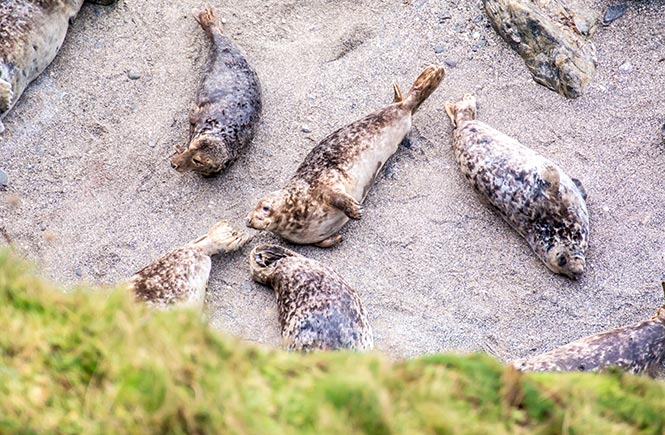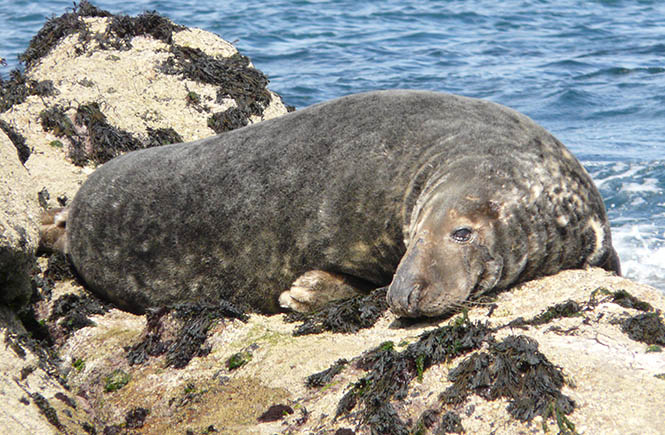Our coastline
The south west’s beautiful coastline is one of our nation’s most treasured natural spaces. Whether walking along the coastpath or being on or in the water itself, it is a place of connection - with nature, each other, and with ourselves.
A rich variety of wildlife calls this space home and can be discovered through the exploration of rockpools and the shallows, or in open water whilst snorkelling or swimming. Clifftop rambles accompanied by breathtaking views provide another huge draw to this unique area of the country, but with domestic holidays rising in popularity, it is more important than ever that we all know how to keep one of our most iconic marine creatures safe - our seals.
Protecting our seals
The UK is home to over a third of the world’s population of grey seals and Europe’s common seals – so it is vital that we do what we can to protect these globally important, keystone species. During the summer months, when coastal areas are at their busiest, seals are also at their most vulnerable to being disturbed.
‘Disturbance’ is defined as "A change in an animal’s behaviour that affects its health, wellbeing or survival", and is caused when people are too close, too visible or too loud around them. If you spot a seal from a distant clifftop, you may not think that your presence, noise or smell have the potential to result in a disturbance event. However, in March and April 2021, walkers were the demographic that caused the most disturbance of any coastal users.
As well as a shared national love of coastal walking, there has recently been a rapid increase in the popularity of wild swimming, which can disrupt the vital life activities of seals, such as resting, pupping, moulting, and digesting food. Because of this, it is key that swimmers are aware of what steps they can take in order to leave the seals they may encounter how they found them.
.jpg)
What does seal disturbance look like?
Disturbance can take many forms and is not always easy to spot. There are several behaviours to look out for, whether you see a seal from land or water, that signals they are aware of your presence and are at risk of being disturbed:
Looking at you – If a seal has noticed you, its fight or flight response has been activated and its stress levels have gone up. Whilst this may seem minimal, seals have been known to stay alert for up to an hour after being disturbed, meaning energy is being wasted instead of stored and mums may be forced to leave their pups.
Stampeding – If seals rush quickly into the sea, a serious disturbance event has occurred which can lead to gashed bellies and ripped out claws.
Tombstoning – If a seal is well above the water line and feels threatened, it may throw itself from a great height into the sea. This is extremely dangerous for both seals and people, and can result in broken jaws and ribs which can be fatal.
Flipper splashing and vocalisation – this is a seal’s way of telling you that you are too close, and it is feeling threatened.
Crash diving – If suddenly distracted whilst feeding in the water, a seal may immediately crash dive. This is a common sign of distress that can alter their oxygen levels, as they will not be fully prepared for the dive and their heart will be racing. It is very important that swimming seals are not disturbed, as this can cause them to stop feeding, impacting their energy supply.

Which seals are worst affected?
Pregnant and pupping females: In the summer months, common seals will be having their pups and grey seals are heavily pregnant. This coincides with many coastal areas being at their busiest. Rushing over sharp rocks can have severe long-term impacts on unborn pups that are not immediately visible.
Pups: Mothers who waste energy fleeing from disturbance cannot pass on the nutrients their young need, and the chances of the pups surviving their first winter are drastically reduced.
Juveniles: With fewer fat reserves, they must conserve energy whenever they can. Younger seals are usually more skittish and so are vulnerable to wasting energy when fleeing from people.
Dominant beachmaster males: these males feed heavily in the summer, enabling them to fast for up to 3 months in the autumn. They do this to protect their pupping females without starving, however disturbance compromises their energy levels and impacts their chances of survival.
The effects of disturbance are often invisible but are always a waste of energy for seals. Some of the physiological impacts of disturbance include increased stress and cortisol levels, a rapid heartbeat, increased breathing rate, cold water shock, cracked ribs, damaged and ripped claws, open wounds, and long-term impacts on unborn and new-born pups as well as moulted pups who are still teaching themselves to feed.

What to do:
Whether you see a seal on land or in the water, wherever possible follow these simple steps to ensure that you do not risk disturbing seals:
- Stay downwind, so seals can’t smell you.
- Keep quiet, so seals can’t hear you.
- Stay out of sight, so seals can’t see you.
- Keep dogs under control and on leads.
- Take any litter home to prevent the risk of ingestion or entanglement.
- Stay on the coastpath, or at least 100m away from seals to avoid encroaching on their space. Avoid any beach where a seal is present.
If a seal approaches you whilst in the water, keep still and avoid making contact or chasing them – they are naturally inquisitive animals but will lose interest if you leave them alone.

Supporting our seals
By following these guidelines, walking and wild swimming enthusiasts can increase their chances of an enjoyable, memorable and positive encounter that keeps both people and seals safe. Whether you are a seasoned coastal explorer or are only beginning to think about venturing down the sea, why not check out our blog posts on wild swimming and beach safety? Or you can utilise the many boat trips in St Ives to see this beautiful creatures with the help of experienced pros.
Aspects Holidays have supported the Cornwall Seal Group Research Trust since 2019, as part of their Corporate Wild Seal Supporter and Adoption Scheme. Like all sponsors, Aspects Holidays receive seasonal updates about their real-life adopted seal ‘Wings’, who has been photo identified and tracked by CSGRT since 2003. Whilst she spends a lot of time around St Ives and the wild bay sites, she is known to have had pups in SW Wales AND Cornwall and has also ventured to Porthcurno on the south Cornish coast. For more real seals, real stories in real time visit: Seal Research Trust

Photos of Wings by Peter Nason, CSGRT
If you would like to help support seal conservation, the Cornwall Seal Group Research Trust and British Divers Marine Life Rescue are always on the lookout for volunteers, supporters and donations. Any contributions you can make will go towards protecting the incredible marine ecosystem on which we all depend for both our physical and mental wellbeing.
.jpg)
Guest blog written by Charlie Gill, CSGRT Marine Stories Ranger
For more information on seals, visit www.cornwallsealgroup.co.uk or www.sealalliance.org.
Tags: South West Coast Path | Wildlife | Environment |
